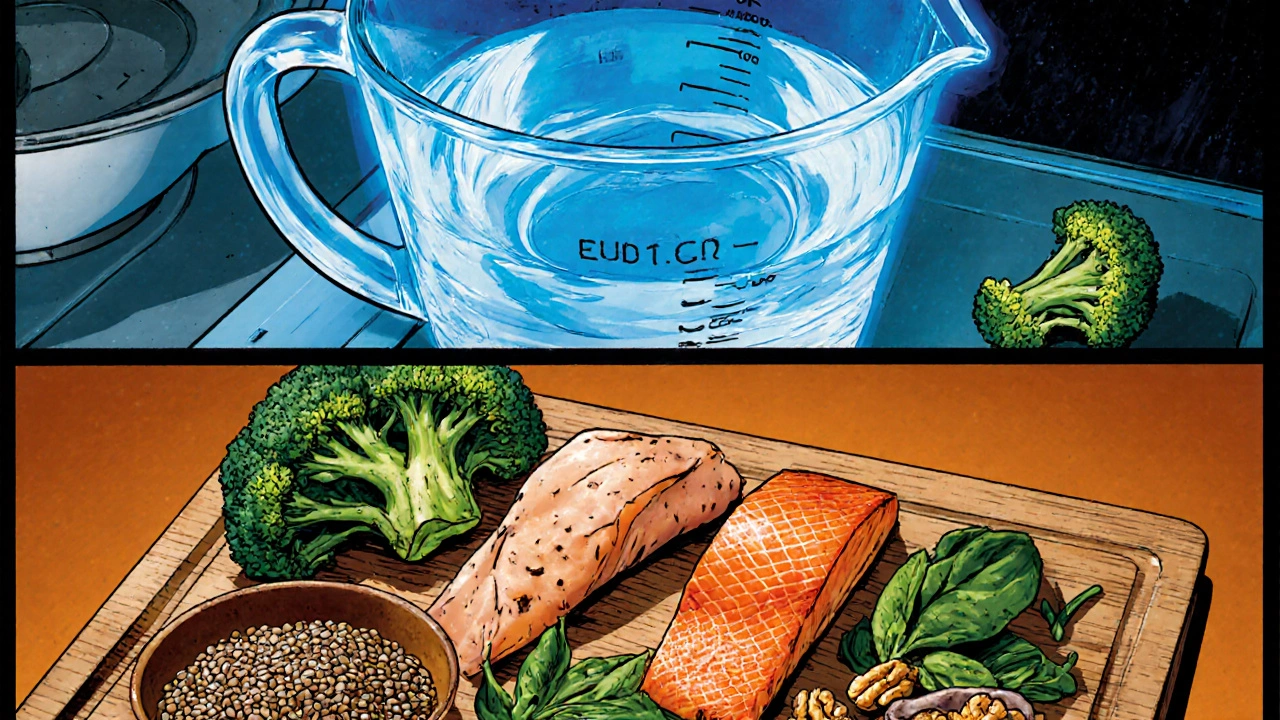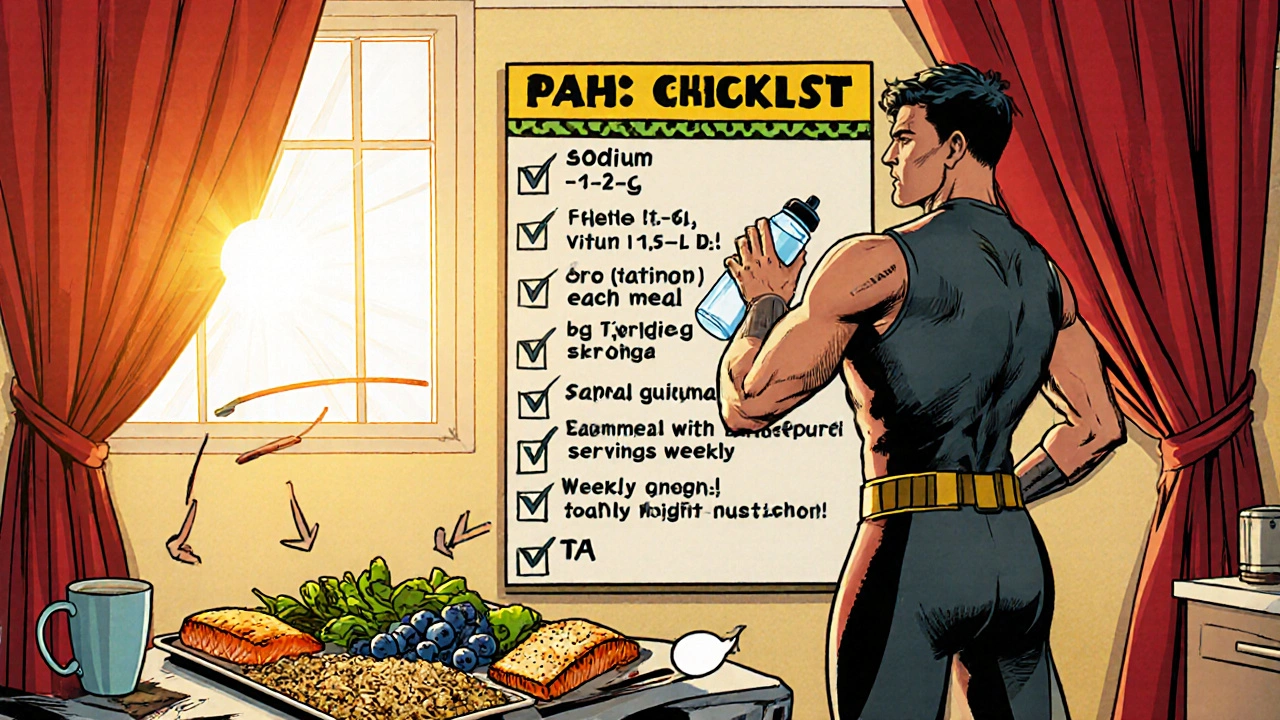PAH Sodium Intake Calculator
Based on PAH dietary guidelines, calculate your daily sodium allowance. Typical recommended limit: 1,500-2,000 mg
Daily Sodium Status
Key Takeaways
- Keep sodium<2g per day and focus on fresh, whole foods.
- Boost iron, vitaminD, and omega‑3 intake to support heart and lung health.
- Monitor fluid intake; most PAH patients benefit from 1.5-2L daily unless advised otherwise.
- Plan meals around lean protein, high‑fiber carbs, and antioxidant‑rich vegetables.
- Use the daily checklist to stay on track and avoid common pitfalls.
Understanding Pulmonary Arterial Hypertension and Nutrition
When you hear Pulmonary Arterial Hypertension is a chronic condition where the arteries that supply blood to the lungs become narrowed, raising pressure and forcing the right side of the heart to work harder, diet often feels like a secondary concern. In reality, what you eat directly influences blood volume, vascular tone, and the side‑effects of the medicines you’re likely taking.
Patients with PAH frequently use medications such as endothelin receptor antagonists, phosphodiesterase‑5 inhibitors, and prostacyclin analogues. Many of these drugs interact with electrolytes, fluid balance, and metabolic rate, so a tailored eating plan can help keep symptoms stable and improve quality of life.
Core Nutrition Principles for PAH
The foundation of any pulmonary arterial hypertension diet rests on three pillars: sodium control, adequate calories, and smart fluid management.
1. Sodium - the biggest enemy
Excess sodium raises blood volume, which can increase pressure in the pulmonary arteries and worsen right‑heart strain. Aim for less than 2grams of sodium a day (about 5g of salt). That translates to roughly one teaspoon of table salt for the entire day.
Practical ways to cut sodium:
- Choose fresh or frozen vegetables over canned versions; if you need canned, rinse them well.
- Swap processed meats (bacon, ham, sausages) for grilled chicken, turkey, or plant‑based proteins.
- Read labels - look for products under 140mg sodium per serving.
2. Calories and Protein - keep your energy up
Because PAH can raise resting metabolic rate, many patients experience unintended weight loss. A daily intake of 25-30kcal per kilogram of ideal body weight usually keeps energy balance in check.
Include 1.2-1.5g of protein per kilogram each day. Good sources are fish, lean poultry, low‑fat dairy, legumes, and tofu.
3. Fluid Management - balance is key
Some PAH patients are on diuretics to control fluid overload. The general recommendation is 1.5-2L of fluids per day, but your doctor may adjust this based on weight and kidney function.
Tips to stay within limits:
- Measure your water intake with a reusable bottle marked in milliliters.
- Replace sugary drinks with herbal tea or sparkling water flavored with a slice of citrus.
- If you feel thirsty often, check for hidden sodium in soups or sauces.

Micronutrients That Matter
Beyond the big three, a handful of vitamins and minerals have a proven impact on PAH outcomes.
Iron - fight anemia and improve exercise tolerance
Iron deficiency is common in PAH and can worsen fatigue. Aim for 15mg of elemental iron daily from foods like lean red meat, lentils, spinach, and fortified cereals.
VitaminD - support heart muscle function
Low vitaminD levels have been linked to poorer right‑ventricular performance. Sunlight exposure (15minutes a day) plus foods such as fatty fish, egg yolks, and fortified dairy can help you reach 800-1000IU per day.
Omega‑3 Fatty Acids - reduce inflammation
EPA and DHA from salmon, mackerel, chia seeds, and walnuts may lower pulmonary vascular resistance. Aim for two servings of oily fish per week or a daily 1g algae‑based supplement.
Antioxidant‑Rich Foods - protect vessels
Berries, dark leafy greens, and green tea supply polyphenols that combat oxidative stress, a driver of arterial narrowing.
When you first introduce these nutrients, consider the following microdata markup to help search engines recognize them:
Low‑Salt Diet is a dietary approach that limits sodium intake to under 2g per day, reducing blood volume and pressure on the pulmonary arteries.
Omega‑3 Fatty Acids are essential polyunsaturated fats found in fish and seeds that help lower inflammation and improve vascular health.
Vitamin D is a fat‑soluble vitamin that supports heart muscle function and immune regulation, often deficient in PAH patients.
Iron Deficiency refers to low levels of iron in the blood that can cause anemia and worsen fatigue in people with pulmonary hypertension.
Diuretics are medications that increase urine output to remove excess fluid, commonly prescribed for PAH patients with right‑heart strain.
Fluid Management involves monitoring and adjusting daily fluid intake to prevent overload while maintaining hydration.
Antioxidant‑Rich Foods are items like berries, leafy greens, and green tea that supply compounds to combat oxidative stress in the pulmonary vessels.
Practical Meal Planning
Putting theory into a daily routine is easier when you have a simple template.
- Breakfast: Oatmeal cooked with unsweetened almond milk, a handful of blueberries, and a sprinkle of ground flaxseed. Add a boiled egg for extra protein.
- Mid‑morning snack: A small apple with 10g of unsalted almonds.
- Lunch: Grilled salmon (100g) over a mixed‑leaf salad drizzled with olive oil and lemon juice, plus a side of quinoa.
- Afternoon snack: Carrot sticks with hummus (low‑salt version).
- Dinner: Stir‑fried chicken breast, broccoli, and bell peppers cooked in garlic‑infused oil, served with brown rice.
- Evening beverage: Herbal tea (e.g., rooibos) and a measured 250ml glass of water.
Adjust portion sizes based on your weight goals and activity level. Use the table below to compare recommended daily intakes for PAH patients versus general adult guidelines.
| Nutrient | PAH Target | General Adult Guideline |
|---|---|---|
| Sodium | < 2g | ≤ 2.3g |
| Potassium | 4.7-5.1g | 3.5-4.7g |
| Fluid | 1.5-2L (or as prescribed) | ≈ 2.5L |
| Iron | 15mg (adult women) / 8mg (adult men) | 8mg (men) / 18mg (women) |
| VitaminD | 800-1,000IU | 600-800IU |
| Omega‑3 (EPA + DHA) | ≥ 1g | 250-500mg |

Common Pitfalls & How to Avoid Them
Even with the best intentions, certain habits can sabotage progress.
- Relying on ready‑made meals: These often contain hidden salts and sugars. Opt for home‑cooked dishes where you control ingredients.
- Skipping meals: Low caloric intake can lead to muscle loss and worsen fatigue. Aim for 5-6 small meals if large portions feel overwhelming.
- Over‑consuming caffeine: While moderate caffeine can be safe, excess can raise heart rate and interfere with some PAH medications.
- Neglecting vitamin D during winter: In Sydney, winter months reduce sunlight. Supplement with 800IU daily during October-April.
- Ignoring food labels: Look for “no added salt” or “low‑sodium” claims, and verify the actual sodium content per serving.
Daily Checklist - Quick Reference for Patients
- ✔️ Check sodium content of every product; stay ≤2g total.
- ✔️ Log fluid intake in a water‑tracking app.
- ✔️ Include a source of iron and vitaminD at each main meal.
- ✔️ Eat at least two servings of oily fish or omega‑3‑rich plant foods weekly.
- ✔️ Review medication timing; avoid high‑potassium foods if on certain diuretics.
- ✔️ Weigh yourself weekly; report sudden changes to your care team.
Frequently Asked Questions
Can I follow a vegetarian diet if I have PAH?
Yes. A well‑planned vegetarian diet can meet the protein and iron needs of PAH patients. Pair legumes with vitaminC‑rich foods (like bell peppers) to improve iron absorption, and consider fortified foods or a supplement for vitaminD.
How much sodium is safe if I’m on a diuretic?
Most clinicians recommend staying below 2g per day for PAH patients on diuretics, but your doctor may set a stricter limit based on blood pressure and kidney function. Always follow your prescriber’s specific guidance.
Is it okay to drink coffee?
Moderate coffee (1-2 cups daily) is generally safe for PAH, but avoid large quantities that could elevate heart rate. If you’re on a medication that interacts with caffeine, check with your pharmacist.
Should I limit potassium because of diuretics?
Some diuretics cause potassium loss, so you may need a higher potassium intake (around 5g per day) from fruits, vegetables, and low‑salt nuts. However, if you’re on a potassium‑sparing diuretic, your doctor might set a lower target. Blood tests guide the exact amount.
Can I use salt substitutes?
Most salt substitutes contain potassium chloride, which can raise potassium levels. If you’re on a potassium‑sparing medication, avoid them unless your doctor approves.
Brett Coombs
October 15, 2025 AT 20:47They’re feeding us sodium junk to keep the pharma cash flowing.
John Hoffmann
October 15, 2025 AT 21:37The sodium recommendation seems overly simplistic. While limiting salt is generally advisable, patients with PAH often require individualized electrolyte monitoring. Moreover, the article neglects recent studies on potassium balance.
Shane matthews
October 15, 2025 AT 22:27I prefer concise advice; the tip about low‑sodium foods is solid, but it could mention reading labels.
Rushikesh Mhetre
October 15, 2025 AT 23:50Nutrition plays a huge role in managing PAH and you can start making changes today.
First, focus on whole foods like fresh vegetables, fruits, and lean proteins.
These options naturally contain lower sodium than processed meals.
Second, stay hydrated; water helps keep your blood vessels flexible.
Third, incorporate omega‑3 rich fish such as salmon or sardines at least twice a week.
The anti‑inflammatory properties of omega‑3 can support lung health.
Fourth, limit caffeine and alcohol because they can affect blood pressure.
Fifth, keep a food diary to track your intake and spot hidden salt sources.
Sixth, experiment with herbs and spices instead of salt for flavor; garlic, lemon, and rosemary work wonders.
Seventh, choose low‑sodium broth or make your own stock at home.
Eighth, read nutrition labels carefully; aim for less than 140 mg of sodium per serving.
Ninth, avoid canned soups and processed meats which are notorious sodium culprits.
Tenth, consider potassium‑rich foods like bananas and sweet potatoes, but consult your doctor first.
Eleventh, stay active with moderate exercise; it complements a healthy diet.
Twelfth, discuss with a dietitian specialized in PAH to personalize your plan.
Thirteenth, remember that gradual changes are more sustainable than drastic overhauls.
Fourteenth, keep an eye on portion sizes to manage calorie intake.
Finally, celebrate small victories and stay motivated-you’ve got this!
Sharath Babu Srinivas
October 16, 2025 AT 00:40Great points, Rushikesh! 🌟 Adding omega‑3 and herbs really helps, and the food diary tip is golden 😊. Keep it up!
zaza oglu
October 16, 2025 AT 01:30Absolutely love the practical steps! 🎉 Remember, everyone’s journey is unique, so tailor these suggestions to how you feel each day. You’re not alone in this.
Vaibhav Sai
October 16, 2025 AT 02:54Awesome rundown! I’d add that rotating different protein sources-like beans, tofu, and lean poultry-keeps meals exciting and nutrient‑dense. Also, don’t forget about the power of fermented foods for gut health. Swapping sugary drinks for infused water can drastically cut hidden salts. Lastly, a weekly meal‑prep session can save time and keep you on track.
Lindy Swanson
October 16, 2025 AT 03:44While the advice sounds solid, some folks swear by high‑salt diets for stamina-maybe it’s worth a trial run.
ravi kumar
October 16, 2025 AT 04:34National pride aside, the science backs low‑sodium for PAH, and ignoring it jeopardizes health. The market pushes salty snacks, but informed choices win the day. Let’s focus on facts, not folklore. Choose wisely.
SandraAnn Clark
October 16, 2025 AT 05:40Nutrition advice is nice but life’s messy.
Rex Wang
October 16, 2025 AT 06:30True, simplicity often beats over‑analysis.